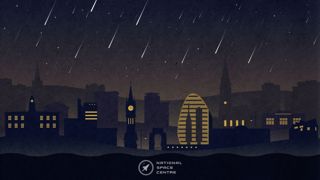
Ursid Meteor Shower 2024
- 29th Nov 2024
- Author: Team Discovery (edited: Dhara Patel)
Hot off the tail of the stunning Geminid meteor shower, comes the Ursids, peaking 21-22 December between midnight and dawn.
Ursids
The Ursid meteor shower is a rather low-key affair. This minor meteor shower produces about 5-10 meteors per hour but could be a good show if the skies are clear. Best viewing will be 21-22 December between midnight and dawn.
The Ursids are produced by dust grains left behind by comet 8P/Tuttle, which was first discovered in 1790. As comets get close to the Sun and the ice which traps material on them is sublimated away, these frozen space rocks shed dust and stones as they whizz around the inner solar system.
And it is this debris along Tuttle’s path that causes the Ursids. As Earth orbits the Sun, it ploughs into the debris trail which enters the Earth’s atmosphere at high speed, heats up and disintegrates in flashes of light that we call meteors.
Comets are renowned for their beautiful tails which are a result of this process. Surrounding the coma or comet head are two tails - the ion tail directed in the opposite direction to the Sun due to its radiation pressure, and the dust tail which trails in a direction that opposes the combined effects of solar radiation and the motion of the comet.
How to Watch from the UK
The Ursids are named after the constellation Ursa Minor as this is the direction from which these meteors appear to originate. While the meteors appear to radiate from this point, they can be best seen 30 degrees away from Ursa Minor, stretching across large sections of the sky. To view the Ursids from the UK, head out between midnight and dawn on 21-22 December.
You do not need to look in any particular direction - in fact, it's helpful to try and scan the whole sky. Lean back, let your eyes adjust to the dark for at least 30 minutes (by avoiding looking at any bright lights), and then observe the entire sky (it helps to have friends to look in different directions).
The darker the location the better, so find the darkest sky you can away from city lights. As always in the UK, clouds can be an issue, but be patient. You can look for the Ursids on other nights either side of the peak as well, but you'll have the best chance on 21-22 December. The shower runs annually between 17-26 December.
The Moon will just be reaching its last quarter phase and will be above the horizon from late evening on 21 December through to sunrise the following morning so moonlight interference will dampen your view. it may be best to observe around midnight when the Moon is still low on the horizon.
Sometimes you can be out for hours so taking a few comforts like a deck chair, a blanket and a hot drink can make the experience more pleasant and enjoyable. With a lower hourly rate than many other meteor showers, you'll need plenty of patience to try and spot some Ursid meteors.
Meteor Infographic
Download our National Space Centre Meteor Shower Guide to make sure you are fully prepared!
Upcoming meteor showers for 2025 include:
Quadrantids
Comet of Origin: The cause of the Quadrantids is a bit of a mystery, but it’s thought that the asteroid 2003 EH1 is the source of the debris.
Radiant: the northern tip of Boötes
Peak Activity: 3-4 January 2025
Peak Activity Meteor Count: up to 80 meteors per hour
Lyrids
Comet of Origin: C/1861 G1 (Thatcher)
Radiant: constellation Lyra
Peak Activity: 22-23 April 2025
Peak Activity Meteor Count: 10-20 meteors per hour
Eta Aquariids
Comet of Origin: 1P/Halley
Radiant: constellation Aquarius
Peak Activity: 5-6 May 2025
Peak Activity Meteor Count: up to 50 meteors per hour
Delta Aquariids
Comet of Origin: 96P/Machholz
Radiant: constellation Aquarius
Peak Activity: 30 July 2025
Peak Activity Meteor Count: up to 15 meteors per hour
Perseids
Comet of Origin: 109P/Swift-Tuttle
Radiant: constellation Perseus
Peak Activity: 12-13 August 2025
Peak Activity Meteor Count: up to 100 meteors per hour
Draconids
Comet of Origin: 21P/Giacobini-Zinner
Radiant: constellation Draco
Peak Activity: 8-9 October 2025
Peak Activity Meteor Count: up to 5 meteors per hour (In rare instances, fiery Draco has been known to spew forth many hundreds of meteors in a single hour.)
Orionids
Comet of Origin: 1P/Halley
Radiant: constellation Orion
Peak Activity: 21-22 October 2025
Peak Activity Meteor Count: up to 20 meteors per hour
Northern Taurids
Comet of Origin: 2P/Encke
Radiant: constellation Taurus
Peak Activity: 11-12 November 2025
Peak Activity Meteor Count: 5 meteors per hour
Leonids
Comet of Origin: 55P/Tempel-Tuttle
Radiant: constellation Leo
Peak Activity: 16-17 November 2025
Peak Activity Meteor Count: up to 10 meteors per hour
Geminids
Asteroid of Origin: 3200 Phaethon
Radiant: constellation Gemini
Peak Activity: 13-14 December 2025
Peak Activity Meteor Count: up to 150 meteors per hour
Ursids
Comet of Origin: 8P/Tuttle
Radiant: constellation Ursa Minor
Peak Activity: 21-22 December 2025
Peak Activity Meteor Count: up to 10 meteors per hour
Happy meteor-gazing!
Full references / credits:
(Banner image) Meteor showers. Credit: © National Space Centre
(1) Anatomy of a comet. Credit: NASA/JPL-Caltech
(2) Radiant of the Ursids. Credit: Stellarium




